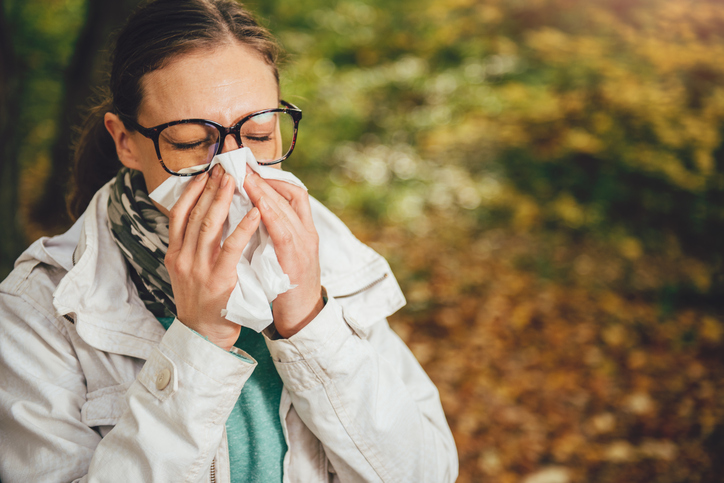Natural Approaches to Fall Allergies
A few other triggers include:
- Mold
- Dust Mites
- Fecal particles from dust mites
- Food Intolerances
- Air pollution
- Grass and Trees
Fall Allergy Symptoms
Here are a few common symptoms that people with fall allergies can have:
- Watery eyes
- Runny nose
- Sneezing
- Coughing
- Itchy eyes
- Itchy nose
- Dark circles under the eyes
Eat Your Way to Relief
Diet is an important part of staying healthy, but did you know certain foods can help lessen allergy symptoms? Broccoli, kale, garlic, onions, collard greens, pumpkins, carrots, and celery are all packed with nutrients which give relief. Some foods which should be avoided or cooked before eaten (because they contain the same allergic proteins in ragweed) are bananas, melons, cucumber, zucchini, and nuts.
Adding foods to your diet that combat allergies such as cauliflower, broccoli, kale, and cabbage has been shown to clear out blocked sinuses. Carrots and the fall favorite, pumpkin, contain allergy-fighting vitamin A. Onions and garlic contain quercetin, nature’s antihistamine.
Apple Cider Vinegar
Apple Cider Vinegar is a traditional remedy that is thought to reduce mucous production and cleanse the lymphatic system. When allergies start, mix a teaspoon of organic, unfiltered apple cider vinegar containing “The Mother” into a glass of water and drink three times per day. (“The Mother” is a colony of beneficial bacteria present in some organic and unfiltered types of apple cider vinegar.)
Quercetin & Nettle Leaf
Quercetin has been shown to keep the mast cells from releasing histamine and reduce inflammation. This bioflavonoid is a potent antioxidant and is usually taken long term. It is best taken in supplement form. Quercetin is a bioflavonoid shown to support sinus and respiratory function, as well as enzyme levels.
Nettle Leaf is another natural anti-histamine and can be taken as a supplement or used in an herbal tea. Nettle leaf has been shown to support immune function, upper respiratory response, and provides tonic properties to the body for overall wellness.
Bromelain
Bromelain, found in pineapples and their stems, contains anti-inflammatory properties which are good for nose and sinus swelling caused by allergies.(4)
An herbal formula providing histamine relief
Natural D-Hist is a blend of flavonoids, antioxidants, proteolytic enzymes and botanicals designed to provide comprehensive support for seasonal challenges caused by common environmental allergens. It also includes quercetin, bromelain, stinging nettles leaf, and N-acetyl cysteine. This herbal combination supports healthy nasal and sinus passages with elevated histamine and respiratory irritation.
Fermented Foods
Fermented foods are strong probiotics containing probiotic microbes that feed on the sugars naturally present in food. Fermented foods are full of beneficial bacteria and yeast which have been shown to support normal immune function, control outbreaks of allergic hypersensitivity and inflammation. (1)(2)
Fermented foods include:
- Fermented vegetables
- Fermented Spirulina
- Kefir
- Kombucha.
TCM approach to fall allergies
In traditional Chinese medicine, cooler temperatures can weaken digestive power, in turn weakening the immune system. People with fall allergies often show signs of spleen or kidney deficiency. TCM approaches often associate Wind invading the upper chamber due to wei (protective Qi) weakening. Drinking hot liquids and dressing warmly are just the beginning of ways to naturally address allergies. Acupuncture is also an important way to relieve allergy symptoms.
Diet plays an important part in fighting seasonal allergies. Dairy and cold foods tend to increase mucus buildup and should be avoided. Soups, vegetables, and grains are easy to digest and lessen mucous build-up. Astragalus is an ancient Chinese immune-enhancing herb and is often used for allergy symptoms. Qing Di Long Pian, also known as Blue Earth Dragon, can help with sinus congestion and sneezing. Jade Screen is another phlegm-resolving herb which dispels wind. Herbs, diet, and acupuncture can be a powerful combination for relief in the fall allergy months.
Embrace the pollen
No, not the pollen causing the allergy – bee pollen. Studies show that the bee pollen found in raw local honey can help you build an immunity to local pollen. (1) Honey also contains enzymes that ward off infections and boost immunity, making it a great pre-winter remedy as well. The recommendation is to take 1 tablespoon per day. It can be added to smoothies, tea or other foods.
Other Remedies
Other things you can do to combat fall allergies include:
- Drink hot liquids and dress warmly
- Make sure to wash pollen off your hair and skin after being outside
- Vacuum and dust often and keep windows closed to keep pollen out of the house
- Check pollen levels before going outdoors
- Try acupuncture, it can help relieve symptoms
Lastly, enjoy the autumn months. Feeling miserable because of allergies is no fun, but making the best of it and enjoying the season to the fullest while reducing your symptoms to allergies can help make this your best fall yet!
References
1.L Macia, et al. Microbial influences on epithelial integrity and immune function as a basis for inflammatory diseases. Immunol. Rev. 2012; 245: 164–176.
2. W Feleszko, et al. Probiotic-induced suppression of allergic sensitization and airway inflammation is associated with an increase of T regulatory-dependent mechanisms in a murine model of asthma. Clin. Exp. Allergy. 2007; 37: 498–505.
3. Saarinen K, Jantunen J, Haahtela T, Birch Pollen Honey for Birch Pollen Allergy – A Randomized Controlled Pilot Study. Int Arch Allergy Immunol 2011;155:160-166
4 Eric R. Secor, Jr., 1 , 2 ,* Steven M. Szczepanek, 3 Christine A. Castater, 2 Alexander J. Adami, 3 Adam P. Matson, 4 Ektor T. Rafti, 4 Linda Guernsey, 3 Prabitha Natarajan, 3 Jeffrey T. McNamara, 5 Craig M. Schramm, 4 Roger S. Thrall, 3 and Lawrence K. Silbart 6. Bromelain Inhibits Allergic Sensitization and Murine Asthma via Modulation of Dendritic Cells. Evid Based Complement Alternat Med. 2013; 2013: 702196.
Published online 2013 Dec 5. doi: 10.1155/2013/702196

Jemile earned a degree in Food Studies and Writing and has worked for almost 23 years in the medical and health industries. She has been a digital marketing consultant for Acupuncture Atlanta since 2011 as the social media manager and content manager. Writing has been a childhood dream for Jemile and writing daily for clients in the health, wellness, food, and art industries have been phenomenal. Jemile is originally from Brooklyn, NY, and lives in the Hudson Valley, NY. She lives with her husband, two daughters, her dog, and two fish. You can contact Jemile via Linkedin, her mom blog, or her website, lunaroseconsulting.com



